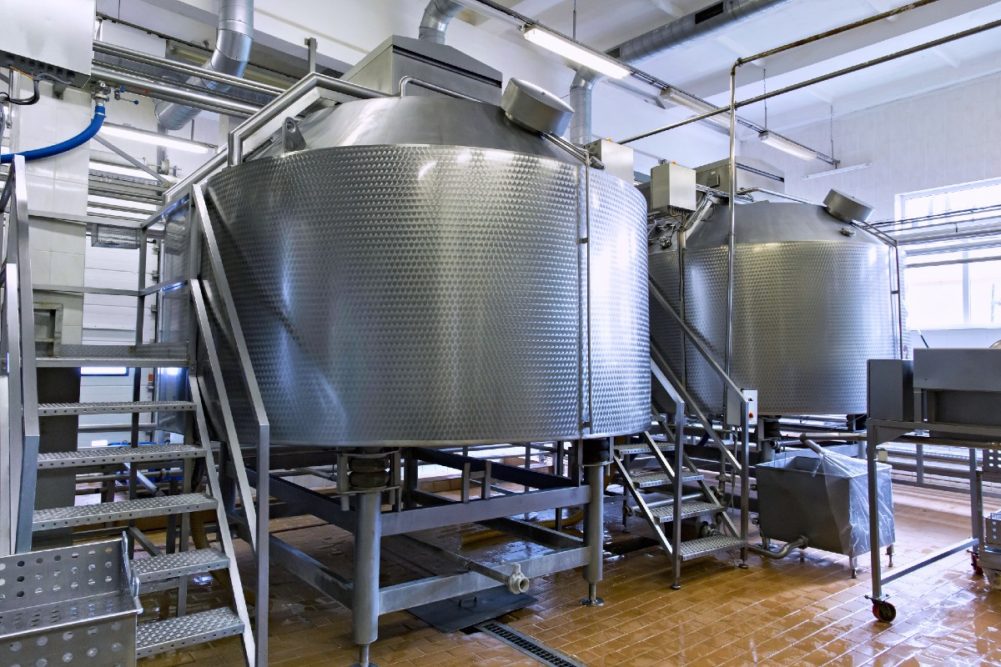Tanks are an integral part of dairy processing machinery, as they are used in various stages of treatment and production. Liquid dairy products like cream, buttermilk or yogurt can be kept fresh for as long as possible using these tanks. They are crucial because they are needed to produce high-quality, safe and fresh products.
Milk tanks, interim tanks and mixing tanks are some types of tanks that are prevalent in a production plant. Most tanks used in dairy production are made of stainless steel because of the durability and cost-effectiveness of the material. Stainless steel is also commonly used in other food processing applications, such as mixing tanks or water tanks, due to these properties.
Storage tanks
The milk storage tank is ideal for cooling and holding milk at a cold temperature until it’s further processed. The machine is made of stainless steel and used to store the raw milk in good condition. These tanks are specifically selected based on the needs and requirements of each individual customer.
Custom built tanks are common since different types of product needs to be processed in a specific way.
Companies such as Paul Mueller Company, Springfield, Mo., offer an array of custom tanks to meet a processor’s unique processing needs from storage to mixing of your final product. Mueller’s custom tanks have double-walled stainless steel design, temperature control, pressure resistance and Temp-Plate energy transfer systems. Mueller works with well known dairy brands including Darigold, Leprino Foods, Hiland Dairy Foods, Saputo and Dannon.
Silo tanks for milk reception belong to the storage category and they vary in size from 25,000 to about 150,000 liters and the wetted surfaces are made of stainless steel. They are often placed outdoors to save on building costs.
In these cases, the tanks are insulated with a double shell design. There are jacketed and double-walled tanks that will help in the insulation of the vessel. The outer shell can be of stainless steel, but for economic reasons, it is usually made of mild steel and coated with anti-corrosion paint. Specific processes require the content to remain at a certain temperature. Effective insulation helps dairy products remain fresh for longer periods of time, reducing waste.
To make complete drainage easy, the bottom of the tanks slope downwards toward the outlet. This is a statutory requirement in some countries. Silo tanks are fitted with various types of agitators and monitoring and control equipment. The number and size of the silo tanks are determined by such factors as the milk intake per day, the number of days per working week, the number of hours per working day (one, two or three shifts), the number of different products to be manufactured and the quantities involved.
Intermediate storage tanks are used to store a product for a short time before it continues along the line, and tanks are helpful in preventing any wastage of product. They are used for buffer storage. After heat treatment and cooling, the milk is pumped to a buffer tank, and from there to filling. If filling is interrupted, the processed milk is buffered in the tank, until operation can be resumed. Similarly, milk from this tank can be used during a temporary processing stoppage.
Clean and sanitized
The dairy industry has some of the highest standards in terms of requirements for cleanliness and processing materials, and tanks used for milk storage need to be inspected to ensure their design, construction and material choice are the most ideal for the purpose. Dairy tanks are made of food-grade stainless steel as it is one of the most sanitary manufacturing options. It is easy to clean and does not stain nor does it absorb any of the products it comes into contact with. Other materials include a variety of plastics, fiberglass, glass lined steel, copper and specialty metals. However these materials are more likely to erode over time.
Stainless steel tanks are designed specifically to resist corrosion even when exposed to moisture for prolonged periods of time. When dairy products are being transferred from one tank to another, they are at the risk of being exposed to bacteria during this transfer period. Tanks need to be thoroughly cleaned in between each load of milk and therefore need to be durable enough to withstand repeated cleaning as well as simple enough to ensure thorough sanitization with each clean.
Cedarstone Industry, Houston, manufactures and supplies both double-shell insulated stainless steel storage tanks with cooling/heating jackets and single wall tanks without insulation and jacket. These tanks are manufactured to be sanitary vessels so they can be used in dairy. The tanks are constructed with either 304 stainless steel or 316L stainless steel for more corrosion resistance, depending on the application.
Frain Industries, Inc., Carol Stream, Ill., also offers an extensive line of stainless steel tanks. These tanks come in a wide range of shapes and sizes based on their application. Tank sizes range from 5 gallons to 10,000 gallons and these tanks can be customized to meet varying application needs.
Dairy tanks are a necessary element of dairy product processing, and yet there are points to consider when determining the design specifics of a tank. Most importantly, a tank needs to be able to be cleaned and sanitized, and inspected for rust or other degradation.
Dairy processing equipment is a long-term investment. Using stainless steel equipment that lasts for years has more value at a reasonable cost. With efficient operation, companies have better flexibility to grow their business.

